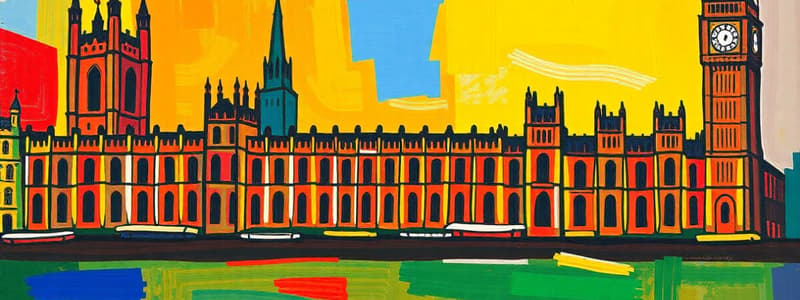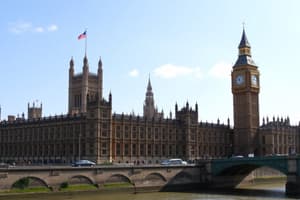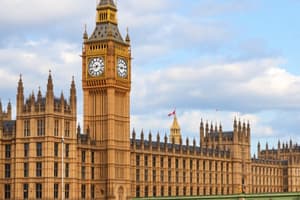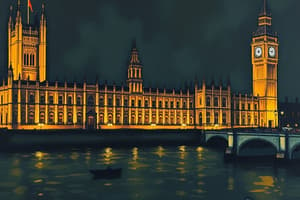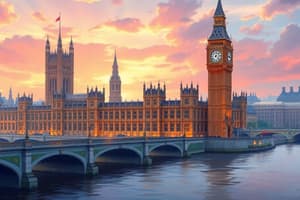Podcast
Questions and Answers
What is the Palace of Westminster commonly called?
What is the Palace of Westminster commonly called?
- Tower of London
- Buckingham Palace
- Houses of Parliament (correct)
- Westminster Abbey
In what city is the Palace of Westminster located?
In what city is the Palace of Westminster located?
- Manchester
- London (correct)
- Cardiff
- Edinburgh
What is the name of the clock tower in the Palace of Westminster?
What is the name of the clock tower in the Palace of Westminster?
- Charles Tower
- Albert Tower
- Victoria Tower
- Elizabeth Tower (correct)
When did the Palace of Westminster become a Grade I listed building?
When did the Palace of Westminster become a Grade I listed building?
Until what year was the Palace of Westminster the primary residence of the kings of England?
Until what year was the Palace of Westminster the primary residence of the kings of England?
What century did construction begin on the replacement Palace of Westminster after the fire?
What century did construction begin on the replacement Palace of Westminster after the fire?
What architectural style was chosen for the rebuilt Palace of Westminster?
What architectural style was chosen for the rebuilt Palace of Westminster?
Which of these is NOT housed within the Palace of Westminster?
Which of these is NOT housed within the Palace of Westminster?
What material was Westminster Hall made of?
What material was Westminster Hall made of?
What is 'Westminster' a metonym for?
What is 'Westminster' a metonym for?
Flashcards
Palace of Westminster
Palace of Westminster
Meeting place of the Parliament of the United Kingdom, located in London.
Big Ben
Big Ben
Nickname for the Elizabeth Tower, a famous landmark.
Westminster
Westminster
Metonym for the UK Parliament and the British Government.
Westminster System
Westminster System
Signup and view all the flashcards
Original Use:
Original Use:
Signup and view all the flashcards
Westminster Hall
Westminster Hall
Signup and view all the flashcards
Charles Barry
Charles Barry
Signup and view all the flashcards
Gothic Revival Style
Gothic Revival Style
Signup and view all the flashcards
Study Notes
- The Palace of Westminster is where the Parliament of the United Kingdom meets, situated in London, England.
- Commonly referred to as the Houses of Parliament, it houses the House of Commons and the House of Lords.
- "Westminster" is a metonym for the UK Parliament, British Government, and the Westminster system of government.
- The Elizabeth Tower, also known as Big Ben, is a recognizable landmark of London and the UK.
- Since 1970, the palace has been a Grade I listed building.
- Since 1987, it has been part of a UNESCO World Heritage Site.
- Originally built in the eleventh century as a royal palace.
- It served as the main residence for the kings of England until 1512, when a fire occurred, destroying the royal apartments.
- The monarch relocated to the nearby Palace of Whitehall with the remainder of the palace continuing to host the Parliament of England since the 13th century.
- A major fire in 1834 destroyed most of the palace.
- The twelfth-century Westminster Hall was preserved and integrated into the new structure.
- Charles Barry won the competition to design the new palace.
- The design showcases a Gothic Revival style.
- Construction began in 1840 and took 30 years to complete.
- Delays, cost overruns, and the deaths of Barry and his assistant, Augustus Pugin, occurred during construction.
- The palace includes chambers for the House of Commons, House of Lords, and the monarch.
- It spans a floor area of 112,476 m2 (1,210,680 sq ft).
- Significant repairs were necessary after the Second World War, including the reconstruction of the Commons chamber.
- The palace requires major repairs, despite ongoing conservation efforts.
Studying That Suits You
Use AI to generate personalized quizzes and flashcards to suit your learning preferences.
